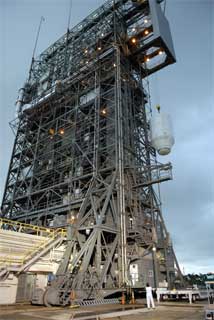 |
| Attached to an overhead crane, the Phoenix spacecraft is lifted alongside the service tower of Launch Pad 17A at Cape Canaveral Air Force Station in Florida. (NASA/George Shelton) |
The countdown clock is really ticking now ├ë Canada├Ľs space-bound weather station is scheduled to blast off╠řSaturday, Aug. 3╠řat 6:26:31 a.m., on the NASA Phoenix Mission to Mars.
╠ř
├ĺNow everything comes down to that 15 seconds,ÔÇŁ says Dr. Tom Duck, co-investigator for the weather station and associate professor in H┬■╗ş├Ľs Department of Physics and Atmospheric Science.
╠ř
├ĺWe really need the launch to go well. And if we get through that OK, then there├Ľs the landing, which is really complex and ambitious.ÔÇŁ
╠ř
He and research associate Cameron Dickinson will be on campus watching the liftoff happen live on NASA TV. The webcast will provide a variety of webcam angles on the Delta II rocket as it leaves Earth. Despite the groggy hour, they├Ľll be joined by a number of media, as well as students and colleagues involved with Dal├Ľs lidar research. The scientists are getting used to working at the crack of dawn, after an avalanche of recent national radio and TV media interest.
╠ř
Tropical storms in Florida delayed the launch by a day ├É severe weather this week prevented the NASA launch team from finishing fueling of the rocket├Ľs second stage. But it├Ľs looking good to go for tomorrow, NASA's Launch Director Chuck Dovale said today at a Phoenix prelaunch news conference. Weather Officer Joel Tumbiolo reports favourable conditions for launch time, with only a 20 per cent chance of weather preventing liftoff.
╠ř
|
╠ř
Drs. Duck and Dickinson can├Ľt wait to see their four years of painstaking work finally embark on its 10-month journey, 680 million kilometres through outer space. They├Ľve been key players in providing scientific and design input to adapt lidar (Light Direction and Ranging) technology for the Canadian weather station.╠ř╠ř
╠ř
The Phoenix lidar will be the first Canadian instrument to track daily weather on another planet ├Ĺ it will measure dust in the Martian atmosphere, and hopefully find evidence of clouds and ice fog.
╠ř
Now snugly aboard the Phoenix rocket, the new lidar equipment is just 6.8 kg, ├ĺabout the size of a breadbox,ÔÇŁ according to master├Ľs student Lucy Crawford, of Carbonear, NL, who has been involved in Dal├Ľs Phoenix effort. That├Ľs considerably smaller than the one on the roof of the Dunn building, which weighs several hundred kilograms and emits a green laser beam above the campus on clear nights. Another Dal lidar project is conducting climate change and pollution studies in the Canadian Arctic.╠ř╠ř
╠ř
├ĺTo be part of a Canadian mission on another planet, I can├Ľt even put that into words,ÔÇŁ says Dr. Dickinson. ├ĺIt├Ľs a first, so there├Ľs extra pressure. We definitely feel that failing is just not an option.ÔÇŁ
╠ř
While the liftoff will be nerve-wracking, a bigger hurdle awaits in May 2008 when Phoenix├Ľs solar-powered lander descends on a previously untouched polar region. If it succeeds, Drs. Duck and Dickinson will join other Canadian scientists in Tucson, Arizona, where they├Ľll use an array of satellites to remotely operate the lidar. The Phoenix Mars lander is also equipped with a robotic arm to dig through Martian soil and ice in the arctic region, and onboard scientific instruments will analyze the samples.
╠ř
├ĺIt├Ľs just very exciting to do something at the very frontier of knowledge,ÔÇŁ says Dr. Dickinson. ├ĺWe├Ľve gone to the depths of the earth, and we├Ľve done a pretty good job of exploring our own planet. This mission is going to push the frontier, certainly for space exploration and for science.ÔÇŁ
╠ř
See live coverage of the Phoenix launch on NASA TV├Ľs webcast at: .
╠ř
Check out NASA's launch blog at: .

